|
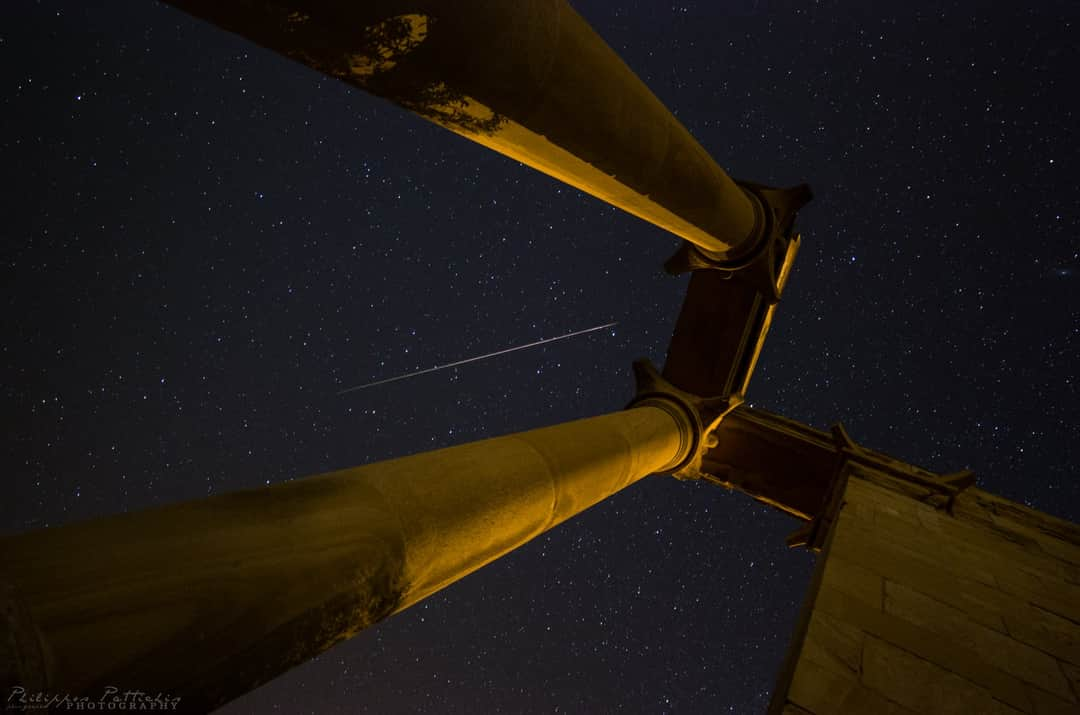 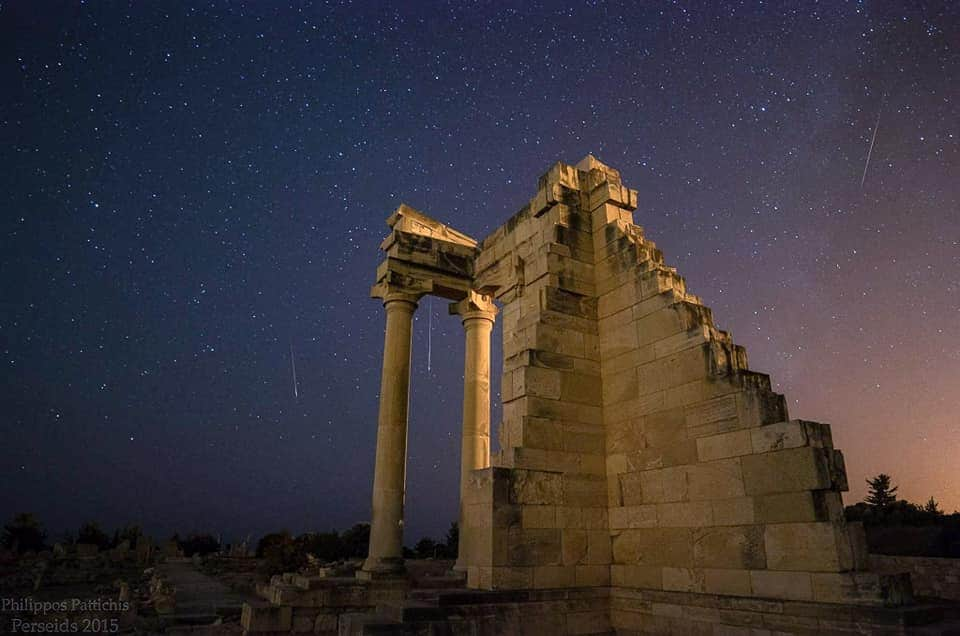 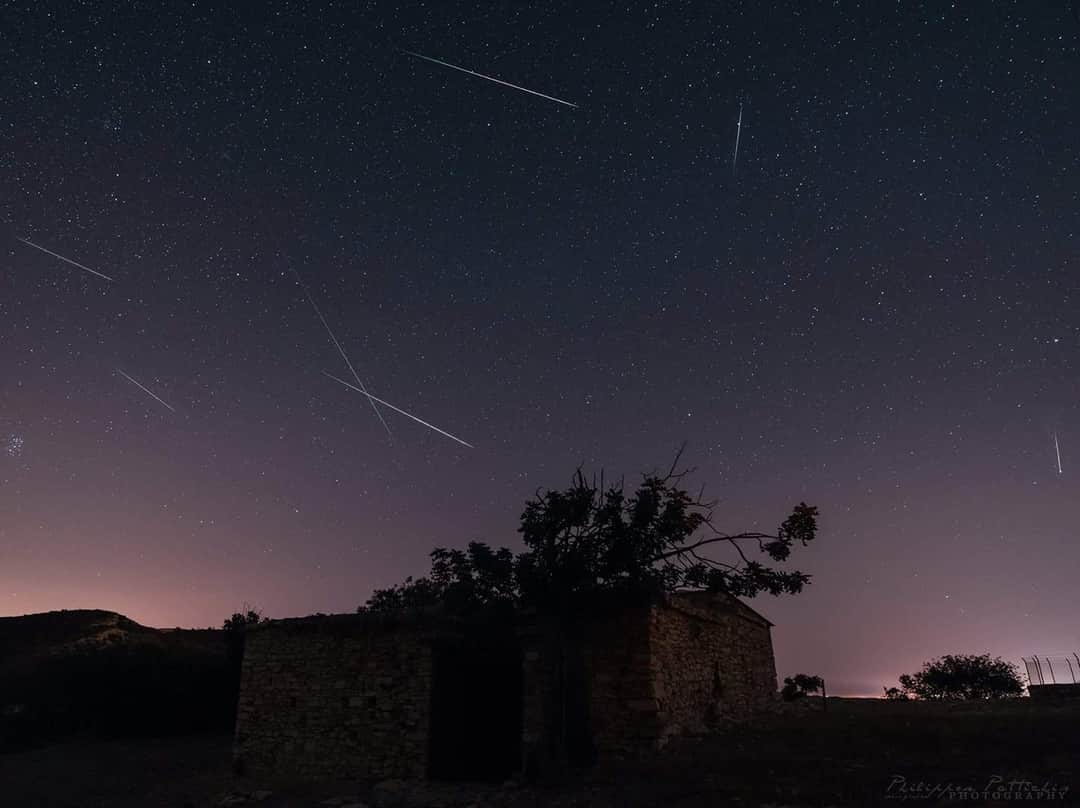
Image Credits: Philippos Pattichis ©
PERSEID METEOR SHOWER 2023
Perseids are probably the most popular meteor shower of the year.
They occur every year between July 17 and August 24.
Most people are on their Summer holidays and have the chance to sit back on their chairs,
relax and watch the Perseids sky show.
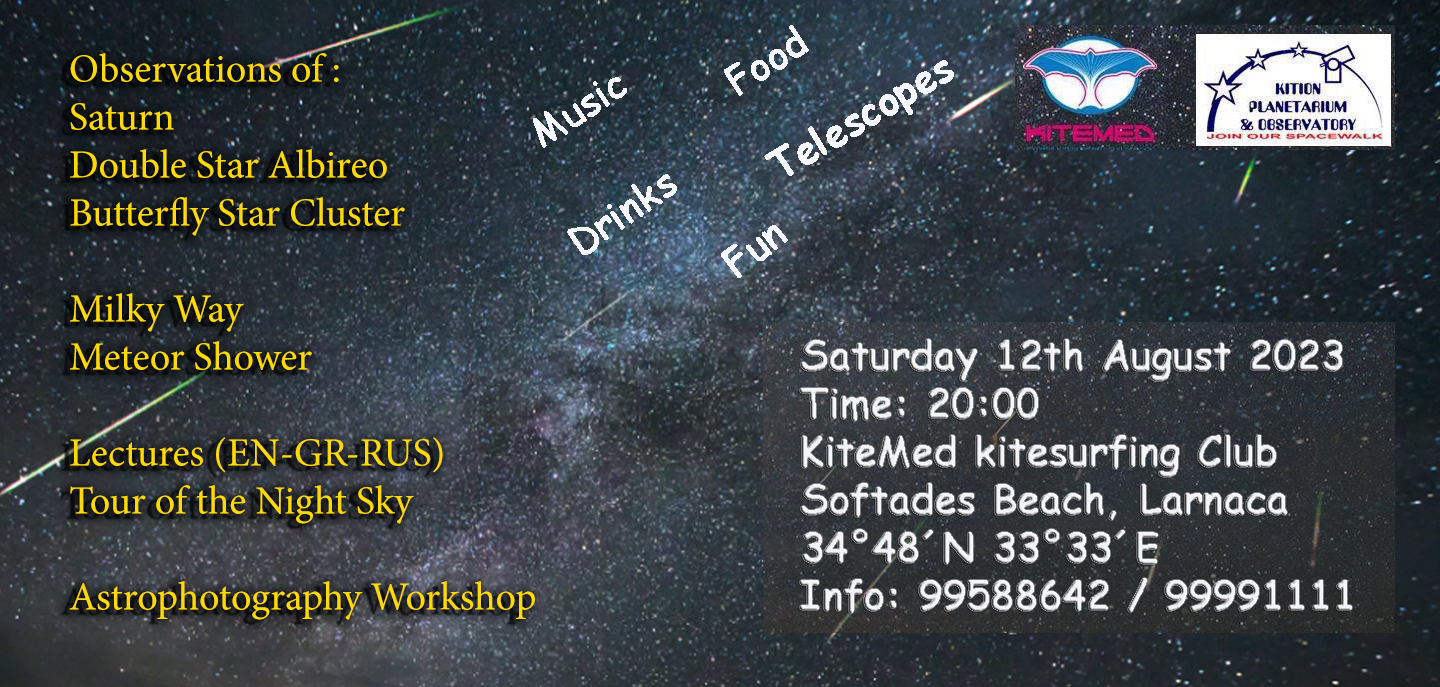
Perseids are already active.
The maximum is expected on August, 13 from 10:00 till 17:00 (Cyprus time) with additional maxima on August,
12 around 23:00, August, 13 at 06:00 and August, 14 between 03:00 and 04:45.
A few notes about observations.
Visit the place, where you want to make observations a day or two in advance. It is good to be there at daytime.
Usually it is wild nature site, so keep in mind local creatures, such as mosquitos and dress properly.
For the first time in last years the expected maximum of Perseids will occur when it will be really dark on the Island.
Large activity of meteors is expected during two nights before and after the maximum.
So you may enjoy meteors and fireballs during that week.
BEST WAY TO OBSERVE
When observing, one should look high enough in the sky.
There are two areas in the sky to avoid during observations.
Avoid observing exactly overhead and avoid observing towards the radiant at the constellation of Perseus.
In the first case, there is a great chance to fall asleep.
In the second case, someone may observe very short and fast, hardly distinguishable meteors.
If the sky for you, is still not like an open book with familiar symbols
and the Perseus constellation is not more understandable for you than 你好, 英仙座!,
then choose the southern part of the sky for observation.
Long Perseids will fly out from behind your head.
If you are planning to do scientific observations feel free to ask questions via
email [email protected]
There are some updates, which may be of interest to you.
The results of the meteor observations will be discussed during the next Science Café meeting on August, 29 2023.
Meeting ID: 831 2336 2644
Passcode: kition
WHAT ARE METEORS?
Meteors or "shooting stars" as many people call them, come from comets.
Most of the annual meteor showers we observe take place as Earth passes through trails of debris left behind
by active comets orbiting the Sun, casting off little bits of dusty debris in their long tails.
The Perseid meteors come from a comet called Swift-Tuttle, which orbits the Sun every 133 years.
They took their name from the constellation of Perseus, as they appear to radiate from a point high in the north,
called the "radiant in the constellation of Perseus.
To observe the shower, you need only point yourself generally toward the north and look up.
SCIENTIFIC OBSERVATIONS
On Sunday, August, 13 the KITION PLANETARIUM & OBSERVATORY invites you to participate in scientific observations of Perseids.
21:15 Gathering at the KITION PLANETARIUM & OBSERVATORY (please inform till Friday, August, 11, that you are coming).
21:30 Discussion of technique and training of meteor observations. (Notebook and pencils are required).
22:15 Departure to a dark site.
23:00 Beginning of observations.
00:30 End of observations
Requirements:
Carton paper
2 pencils
Red torch (optional)
Folded chaise-longue or any other convenient for you chair or similar
Clothes with long sleeves
Closed shoes
Mosquito reppelent
Snacks
Fireballs

Image Credits: Philippos Pattichis ©
Fireballs
The KITON PLANETARIUM & OBSERVATORY is the official Cyprus National Point of Contact
for the IMO (International Meteor Organizations) for Fireballs.
Please read below what Fireballs are and send us an e-mail to [email protected] with videos or pictures of fireballs you observed
and a bried description of your experience for further scientific investigation and research.
Fireballs are meteors that appear brighter than normal. A great majority of the material orbiting in outer space are tiny sub-millimeter sized bits of stone, ice, or metal, or a combination of these materials. These are known as micrometeoroids or simply space dust. These tiny fragments cannot produce enough light to be seen when encountering the atmosphere and yet they contribute many tons of material to the Earth’s weight each year. As the size of these objects approach a millimeter, they begin to produce enough light to be seen upon entry to the upper atmosphere as ordinary meteors. Due to the velocity at which they strike the Earth’s atmosphere, fragments larger than 1 millimeter have the capability to produce a bright flash as they streak through the heavens above. These bright meteors are what we call fireballs and they often strike fear and awe for those who witness them.
Fireballs actually occur every day all over the Earth. To the individual though, they are a rare spectacle that is witnessed very few times per lifetime. It must be remembered that fireballs also occur during the day or on a cloudy night. They also occur over the ocean or over uninhabited portions of land. Even if a fireball occurs over your location, you need to be outside facing the right direction or you will still miss it. Therefore the International Meteor Organization takes keen interest in these sightings in the hope that its origin can be determined and that perhaps meteorites can be recovered.
Only true fireballs have the ability to survive all the way down to the Earth’s surface. Therefore we must limit the reports to only include true fireballs and not ordinary meteors. The easiest method to determine whether a meteor was a fireball or not, is to estimate its brightness. If the object you witnessed is brighter than any object in the sky except for the sun and the moon, then it is a fireball. Another important factor is the duration of a fireball. While larger than most all other meteors entering the atmosphere, they still are traveling at tremendous velocities. Like ordinary meteors, they will suffer disintegration and will slow down to the point where they no longer produce light. This usually takes only a few seconds. Rarely a very large fireball will last 5-10 seconds before it is extinguished. If your object lasts in excess of 10 seconds it is most likely a satellite or some sort of aircraft and not a fireball.
If you are certain your object qualifies as a fireball, then there is some important information you should recall about this event. First of all we need the date and time (as accurate as possible!). Your geographic location is also very important if we are to determine the correct trajectory of this object. Also important is the length and direction in which the fireball was moving. The beginning and end points are helpful too, especially if you can provide references to stars and constellations. Compass directions and altitude above the horizon will help too.
The brightness is difficult to estimate but most fireballs are usually in the range of magnitude -5 to -10. Magnitude -5 is equivalent to the planet Venus at its brightest. At this magnitude a fireball can cast a very faint shadow under the darkest conditions. As fireballs increase in brightest (from -5 to -10) the shadows become pronounced and easier to see. At magnitude -9, the light from a fireball is equivalent to the light produced by a half-illuminated moon. At magnitude -13, the light from a fireball is equivalent to the light produced by a full moon. Fireballs brighter than the full moon are exceedingly rare.
Other factors that you may recall are the colors of your fireball, if any. Colors that are produced by swift fireballs usually are the result of ionization of high altitude molecules. Colors produced by slower fireballs may actually indicate the chemical composition of the meteoroid. You can also record whether the fireball left a persistent train after it has disappeared. This phenomenon is usually limited to swift fireballs. Be sure to listen for sounds, especially after very bright fireballs. These sounds usually occur as a sonic boom a minute or two after the fireball has occurred.
Individual reports to the International Meteor Organization are shared and saved for statistical study purposes. Reports are also shared with the general public in the form of our Fireball Sightings Log, which allows visitors to monitor the fireball activity which is reported to us from across the world. This also allows contributors to share their sightings and to verify whether there are other witnesses to their event.
If you have seen one of these rare events, please take the time to share your sighting with our global community. It does not matter if it occurred last night or in years past, information on your event is valuable! Please report your sighting via the online Fireball Report Form.
If you are familiar with viewing meteors then you will know that most meteors seen in the course of an observing session are faint ones. Only a small fraction exceed magnitude 0 which are caused by millimeter-sized meteoroids. About one in 1,200 observed meteors becomes brighter than -5 mag, while only one in 12,000 reaches -8 mag (Rendtel and Knöfel, 1989).
The definition of a fireball is somewhat arbitrary and in the literature the required minimum magnitude varies between about -2 mag to -6 mag. We regard meteors of at least apparent magnitude -3 mag (corrected for zenith position) as fireballs. By zenithal magnitude we mean the brightness the meteor would have if it had appeared in the zenith of the observing site. As an example, a meteor appearing like -1 mag may actually be a fireball if it moves only a few degrees above the horizon. The apparent brightness decreases with the square of the distance between object and observer, and furthermore, the absorption of the light is proportional to the optical path length as well. In the case of a near-horizon meteor, the distance to the observer is very large resulting in a strong reduction of the apparent brightness.
To put this way round: a fireball of -6 mag zenithal magnitude terminating about 50 km above Earth’s surface will appear as a meteor of -1 mag at an elevation of 5 degrees above the horizon for an observer 600 km from the event. The zenithal magnitude for visual observations can be calculated using the formula:
M = m + 5 log (sin h)
where M is the zenithal magnitude, m the apparent magnitude and h the elevation of the event above the horizon.
So-called radio fireballs are meteors captured by a receiver using the forward-scatter method whose echo-duration is longer than 10 seconds. Due to the very complicated physical relationships, a straightforward conversion of the echo duration into a visual magnitude is not possible.
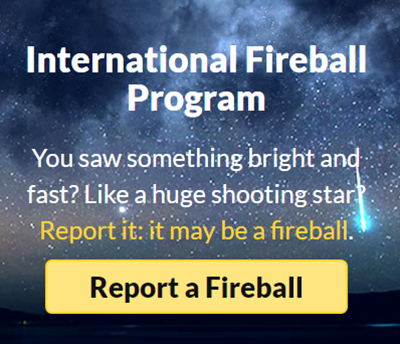
8 SEPTEMBER 23:48 |
FIREBALL OVER CYPRUS.
THE KITION PLANETARIUM COLLECTED VIDEOS AND TESTIMONIES FROM OBSERVERS.
THE RESULTS WERE PUBLISHES AND SUBMITED TO THE INTERNATIONAL METEOR ORGANIZATION DATABASE

|
10 OCTOBER 06:33 |
FIREBALL OVER CYPRUS.
THE KITION PLANETARIUM COLLECTED VIDEOS AND TESTIMONIES FROM OBSERVERS.
THE RESULTS WERE PUBLISHES AND SUBMITED TO THE INTERNATIONAL METEOR ORGANIZATION DATABASE |
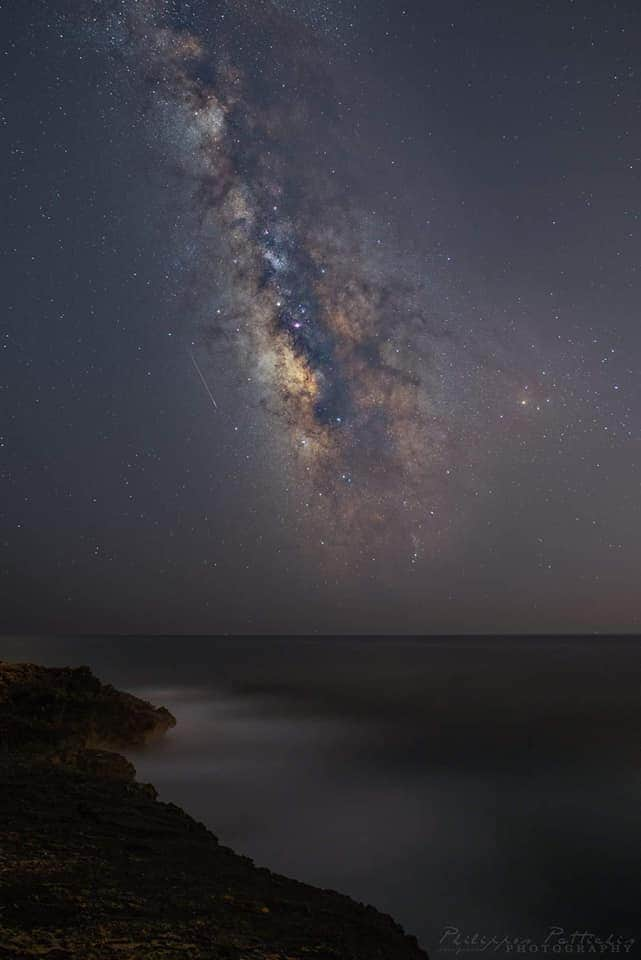
Image Credits: Philippos Pattichis ©
If you have any querries or suggestions, do not hesitate to contact us via e-mail or call +357 9999 1111.
LINKS:
KITION PLANETARIUM & OBSERVATORY FB PAGE
https://www.facebook.com/groups/kition
INTERNATIONAL METEOR ORGANIZATION
https://www.imo.net/ |
Join our spacewalk...
| 